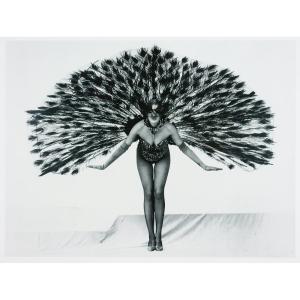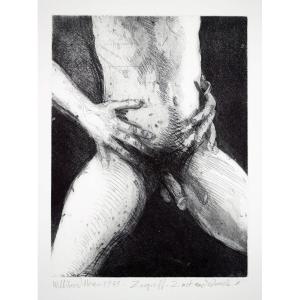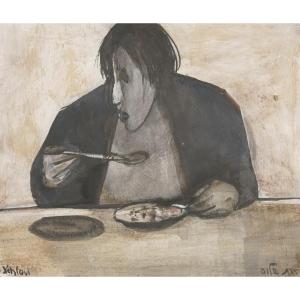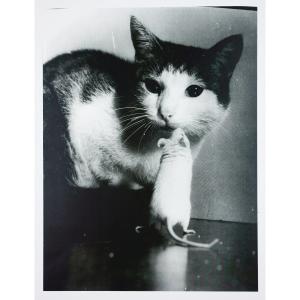- Cornersoccasionally slightly bumped, minimal crease, otherwise in very good condition
- DancingSculpture -
In thisseries of images, Gerlinde Beck uses printmaking to bring a "dancingsculpture" to life, intensifying the sculptural tension and illustratingher understanding of the sculpture as dynamic. A conically cut cube towersabove the picture format and floats on a fragile, multilayered substructurethat converges with the cube at one point. A steel girder-like plate penetratesthis formation, serving as both the foundation and an element of the sculptureitself. The shiny, silver background blends with the color of the dancingsculpture, creating the impression of a metallic arrangement.
"Atthe time, my work explored the aspect of the illusory. It is a play betweentwo- and three-dimensional thinking."
GerlindeBeck
About the artist
GerlindeBeck studied at the Stuttgart Academy of Arts from 1949 to 1956 under KarlHils, Peter Otto Heim, Gerhard Gollwitzer, and Willi Baumeister. She alsotrained as a precision sheet metal worker. In 1953, she took her first trip toParis, where she encountered Henry Moore's sculptures and found inspiration inAfrican art. In 1956, she married musician Hans-Peter Beck. That same year, sheand Wolfgang Reiner founded a screen printing company that produced prints forIda Kerkovius and Fritz Winter. After briefly working as a design teacher at anindustrial company in Stuttgart in 1958, Gerlinde Beck worked as a freelanceartist. From the 1960s onward, she was one of the leading sculptors of hergeneration in Germany. Starting in 1965, she created graphic works as well assculptures. In 1968, the Kunsthalle Mannheim organized an exhibition of herart, and in 1969, the Wilhelm-Lehmbruck-Museum in Duisburg did the same. Theseexhibitions brought Gerlinde Beck international recognition. In 1974, her majorwork, "Klangstraße," was performed for the first time. In 1977, the Museum am Ostwall in Dortmundheld a major retrospective of her art. This was followed by numerous publiccommissions. In 1984, she received the Federal Cross of Merit, and in 1989, shewas awarded a professorship. In 1996, she founded the Gerlinde Beck Foundationat Schloss Dätzingen in Grafenau.Through herlight fugues, sound sculptures, sound spaces, and spatial choreographies, aswell as her memory and foreboding images, she expanded the boundaries ofsculpture.
"Whenmy critics say I'm taking things to extremes, they're right. But I'm notturning the laws of physics on their head."
GerlindeBeck




































 Le Magazine de PROANTIC
Le Magazine de PROANTIC TRÉSORS Magazine
TRÉSORS Magazine Rivista Artiquariato
Rivista Artiquariato